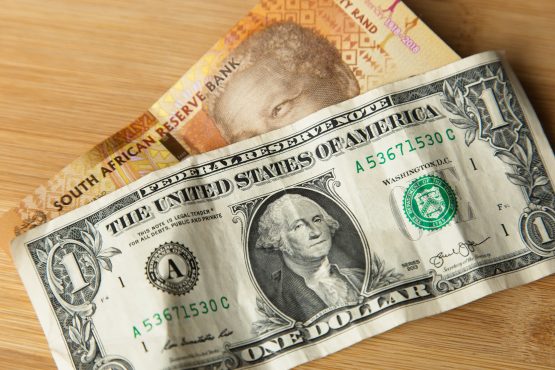The rand has recently shown remarkable strength against the US dollar, influenced by both international and domestic factors. As of May 16, 2024, the rand has made incremental gains, reaching R18.23/USD. This increase is partly due to a reduced risk premium in South Africa’s currency and bond yields as the likelihood of an ANC-EFF coalition diminishes.
Investors are now questioning whether the rand’s strength is due to its inherent strength or the weakening of the US dollar.
| ZAR to major global currencies | |||||
| Quarter to date | Historical ZAR rate | Current ZAR rate | Change | ||
| USD | 17/02/2024 | 18.97 | 18.33 | 3.35% | |
| GBP | 17/02/2024 | 23.88 | 23.1 | 3.27% | |
Below are some of the factors to consider:
- The US Federal Reserve
One significant factor contributing to the rand’s strength is the potential for lower interest rates in the United States. The Federal Reserve has indicated that it might cut rates due to concerns over slowing economic growth and potentially subdued inflation down the line. Lower interest rates in the US reduce the appeal of the dollar for investors seeking higher returns, leading to a weaker dollar. As a result, emerging market currencies like the rand become more attractive to investors, who can potentially earn higher yields on their emerging markets exposure.
- Global economic shifts
As other major economies show signs of recovery and stability, their currencies have strengthened. For example, economic resilience in the Eurozone and the UK has made the euro and the pound more attractive to investors compared to the dollar.
- US trade deficit
Another contributing factor is the expanding US trade deficit. A higher trade deficit means more dollars are circulating outside the US, exerting downward pressure on the currency. Additionally, fiscal policies, including high government spending and debt levels, have raised concerns about the long-term sustainability of the US economy, further weakening the dollar.
The weakening of the US dollar against the rand and other global currencies in 2024 can be partially attributed to a combination of domestic monetary policy shifts, global economic improvements, and specific fiscal challenges.
As the US navigates these issues, its currency’s performance will continue to be influenced by both internal and external factors. Over the past 10 years, the US dollar has strengthened by 24.65% against the pound and by 20.82% against the euro.
However, in 2024, the performance of the US dollar has been marked by volatility and a general weakening trend against several global currencies (as shown below):
| US dollar performance | |||||
| Quarter to date | Historical USD rate | Current USD rate | Change | ||
| GBP | 17/02/2024 | 1.26 | 1.2672 | -0.63% | |
| EUR | 17/02/2024 | 1.0777 | 1.0844 | -0.62% | |
| Five years ago | Historical USD rate | Current USD rate | Change | ||
| GBP | 15/05/2019 | 1.28 | 1.2672 | 0.96% | |
| EUR | 15/05/2019 | 1.1156 | 1.0844 | 2.80% | |
| 10 years ago | Current USD rate | Change | |||
| GBP | 17/05/2014 | 1.6816 | 1.2672 | 24.64% | |
| EUR | 17/05/2014 | 1.3695 | 1.0844 | 20.82% | |
- Electoral outlook in South Africa
Domestically, the political landscape in South Africa has been showing signs of stability and positivity, which has bolstered the rand. The reduced probability of an ANC-EFF coalition has been a key factor in this support. According to the Ipsos poll and several other polls conducted in April, the ANC’s support stands just above 40%. The prior rise of the EFF has been curtailed by the emergence of the MK Party, leading to strengthened bond yields and a more favourable outlook for the rand. However, the political landscape remains extremely volatile and will continue to influence the rand, driving it higher or lower based on the prevailing stability. This ongoing volatility means that while recent trends are positive, the currency’s future movements will closely follow political developments.
- Easing load shedding and economic resilience
Another crucial factor has been the improvement in South Africa’s power crisis management. Easing load shedding by Eskom has significantly improved the business environment and investor sentiment outlook. South Africa’s economy has shown resilience by avoiding a recession, with a modest GDP growth of 0.4% in the first quarter of 2024. This economic stability has highlighted the rand’s performance, making it more robust against the dollar
The strengthening of the rand against the dollar can be attributed to a confluence of international monetary policy shifts, domestic political optimism, and improved economic conditions. These factors together create a more favourable environment for the rand, enhancing its attractiveness to global investors.
Conclusion and house view
Our house view is that South Africa’s structural economic issues – persistent power (and potentially water) shortages, high unemployment rates, and political instability – will continue to exert downward pressure on the rand in the long term. These fundamental challenges are expected to weaken the rand annually against the dollar, despite short-term fluctuations.
Given the current strength of the rand, we believe this is an opportune moment for investors and individuals to convert their ZAR holdings into hard currency. Taking advantage of the strong rand now allows for strategic positioning before the anticipated long-term depreciation. This conversion can provide a hedge against future declines and benefit from the relatively favourable exchange rate.
Converting ZAR to hard currency at this juncture is a prudent move to capitalise on the current favourable conditions. It is important to recognise that this gain is likely to be short-lived. As shown below, over a longer term, the ZAR has continually depreciated:




